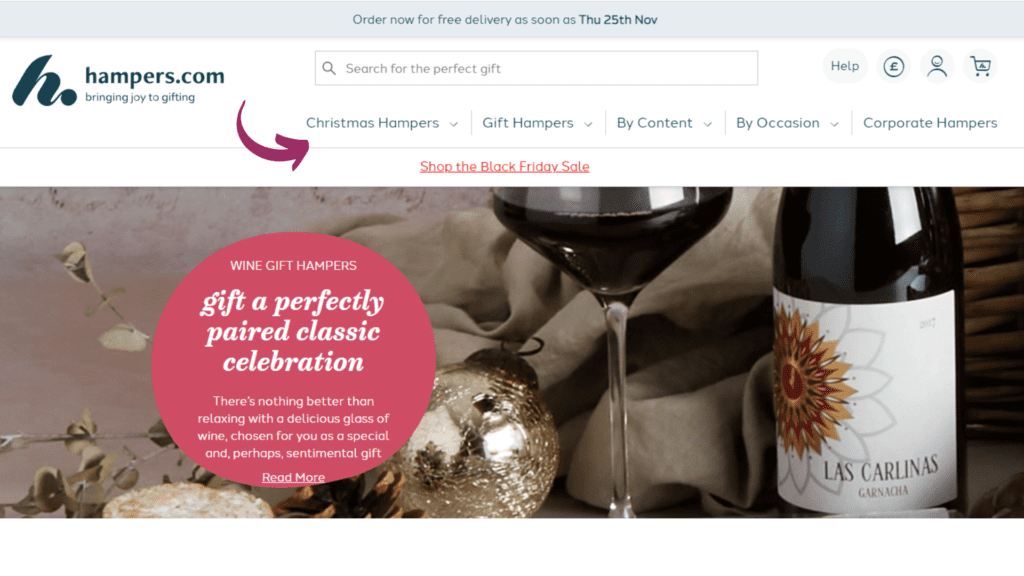
Improving your product-based business’ website
If you have a website for your product-based business, it is likely that you are updating product pages and adding, as well as removing, items regularly. But what about other pages on your website? Are you making the most of them? Are they working hard from an SEO point of view?
Below you can find some recommendations for updating and improving your product-based or e-commerce website.
Page-by-page recommendations for a product-based business’ website
Home page
I often describe the home page of a website as the shop window of an online business. So ensure you have a plan to update it regularly. Whether it’s promoting different products or running seasonal offers, you want to highlight what you offer in a comprehensive and relevant way.
Consider also that some website visitors may not be there just to buy a product – they could go straight to a category or product page for that. They may be looking for information about your product-based business. Therefore, it is a good place to showcase recent blogs and also your social links and posts.
On your product-based business’ website, your home page is one of the primary places that search engines scan to figure out what your e-commerce or online shop is all about, so think carefully about the headings you use and the text you include to ensure they are keyword rich and match the searches or words your ideal customers are likely to be using.
Don’t forget testimonials or reviews can be showcased here, as well as being regularly changed and updated too.
About
Do you have an interesting story to tell? Do you have a unique approach? Do you work with interesting people, suppliers or producers?
If the answer is yes, then your about page is a great place to share this information (as well as on your social media platforms and in blogs!).
As a small and independent business, it’s great to show off what makes your business unique and what values underpin what you make and/or sell.
If relevant, you can also include links, logos and/or imagery of any qualifications you have, memberships you hold and institutions or professional bodies you belong to.
Don’t forget to mention any physical (or brick!) retail outlets, as well as events, where your products can be purchased. This could be important enough to be on the homepage or a separate page of listings, as well. Build backlinks by linking to the shop, cafe or event website or social media page too.
Category pages
Category pages often look stunning with lots of imagery of your products, their names and prices – with hopefully a clear call to action button. However, this means they are also very light on text. Word count is important for SEO, so it is important to consider ways to include text naturally.
Firstly, consider what you want your customers to see above the fold (ATF) (i.e. images and words they will see without scrolling). Good practice for ATF content is to offer a keyword rich summary of the category. Ensure the category name itself is keyword rich too and relatively unique, i.e. not ‘gifts’
Secondly, consider your below the fold (BTF) content – ideally, this is text that includes headings and paragraphs at the bottom of the page. You can discuss intent and make recommendations.
You can see a good example here: https://www.hampers.com/wine-hampers
One last point for categories, consider ways you can group your products in different ways depending on intent/related keywords. Again, hampers.com is a good example of how their products are grouped in different ways to satisfy different search intents.

Product pages
For a product-based business, your product pages on your website will be the most important. They are key landing pages. Make sure that your imagery is high quality and really clear. Buying online is very different to seeing something physically, so consider what images will showcase your product in the best way, and also if you want to include both a ‘main image’ as well as close up or products in use, etc. Depending on your website’s functionality, you may be able to offer a zoom in function or a slider of images. You may also want to include a short video.
In terms of the descriptions of your projects, ensure you balance both enticing ‘sales’ copy with clear descriptions and keywords, as well as important information you need to convey. For example, allergy advice, or if there is anything that needs personalisation, or ordering details.
Try also to make your product descriptions consistent – unless you have a specific hero product – you don’t want to inadvertently show ‘favouritism!’
Importantly, ensure your ‘buy now’ or ‘add to basket’ button is really clear. I would suggest making it the same on every page so that people become really familiar with it, what it looks like and where to find it.
Finally, I know for most product-based business’ websites, the easiest way to add a new product page is to replicate an old one. This is good practice and probably nice and easy for you. However, do be aware of exactly what is being replicated each time, not just on the page, but ‘off page’ or in the ‘back end’ of your website too. For example, does the page have a unique url, meta title and description. You don’t want your pages to cannibalise each other and affect SEO.
Blogs
I highly recommend the addition of a blog to a product-based business’ website, it adds an extra dimension to your business and gives customers another reason to visit your website, even when they are not quite ready or looking to buy.
You can be really varied with what you offer. Fortnum and Mason have a great ‘Our Stories‘ section and Fat Face offers some nice ‘advice’ based ideas – see their blog here.
If you create recommendation lists (aka listicles) or create any blog where you link directly to a product, remember to make a note of this and update or change should you ever need to hide or move this product page, as well as if you stop selling this specific product. As a back up, you can also link to category pages, rather than specific products in some blogs.
If you want more blog ideas, then take a look at my recent blog:
Information pages
From a SEO point of view, as well as a customer service point of view, you may also want to ensure that you include several ‘information page’. This can include delivery, retail, refunds and other important information to help customer’s purchase. You may also wish to include a Frequently Asked Questions page. This is a useful for page for adding regular updates.
Finally, you should also consider the addition of a mailing list pop up. Most product-based businesses lend themselves naturally to having a mailing list. Why? Because to create an account and/or checkout on an e-commerce site, customers will have to give you their email address for you to send a receipt or confirmation of the order, and possibly, follow up delivery information. By asking customers to agree to receiving marketing material too, you have a really easy way of building a mailing list of customers. You can also capture the email of prospective clients by using a pop up or sign up form in the footer of your website. Consider offering a lead magnet, such as a small discount or special offer for signing up.
And then remember to email your customers and mailing list subscribers regularly. Emails are fantastic to show case your products, encourage people to read new blog posts, highlight social media accounts and posts, as well as running exclusive discounts or special offers, and advertising sales and events.
Fancy a review of your product-based business’ website?
Like any business, it can be difficult to keep on top of everything. With your website, little and often is much better than one big redesign once a year. So take the improvement suggestions just a few at a time. I don’t want you to feel overwhelmed.
Importantly, your website should be an easy-to-use purchasing portal. If you are worried it is confusing or unclear for your potential customers, and you are not seeing the conversion or purchases you hoped for, then give me a shout. I can be a ‘fresh pair of eyes’, review your site and make recommendations, from as little as £95.
For more information about my website services, visit my Website Copywriting page.